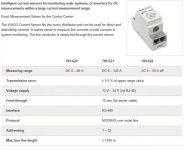We have a customer that wants to monitor current on all the 480v motors on a piece of equipment - 5-6 motors, all 5 HP or less. Ideally, I'd like to find something with Ethernet/IP comms to eliminate adding another analog input card to the PLC, but that's not necessarily required. We could just put VFD's on everthing, but that seems like overkill and cabinet space may be a bit of an issue. I looked at the AB E300 overloads, but those look to be about the same price as just using a VFD. Current doughnuts and a transducer are an option, but I was hoping there was a more elegant solution.
Motor Current Monitoring
- Thread starter Old No. 7
- Start date
Similar Topics
Hello, I was wondering if anyone got any suggestions for equipment that might be used to determine if a motor is running or not. Nothing too...
Greetings from Michigan.
I have an application where we want to monitor voltage and current coming off the output side of the AC motor drive. We...
Motor control advice,
I've been programming a transfer system that transfers parts from one station to the next. The FWD and REV travel is...
HI
i have a delta VFD M-series in the manual, in order to enter the motor rated current you set the parameter P,52 =the motor rated current
my...
Hey guys.
So I have a 50 HP 460/600V motor on a PF525. I've verified the motor is wired correctly. The service factor is 1.15 and the pf is 0.8...






